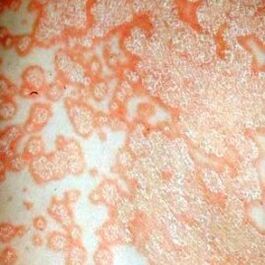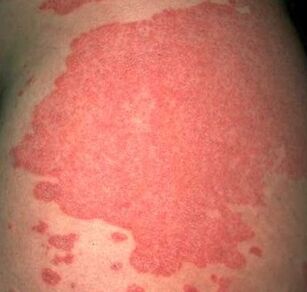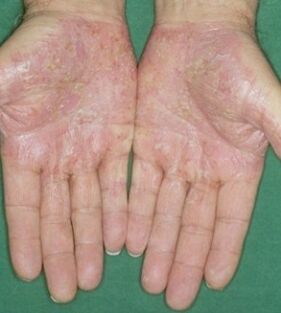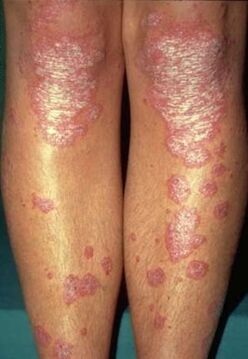
Psoriasis is a non-contagious chronic skin disease. This disease is recurrent. Very rarely, psoriasis can affect the joints, nails, and mucous membranes. People of all ages are susceptible to psoriatic disease. According to statistics, there has been a trend to the development of the disease in childhood.
Psoriasis is by no means a contagious disease of a chronic nature. Most dermatologists tend to believe that psoriasis is a systemic disease. In his opinion, the disease affects not only a specific area of the skin, but also attracts almost all body systems (endocrine, immune, nervous) to the pathological process.
From the outside, psoriasis may appear to be a mild disease. But in reality, this is far from the case. The disease is dangerous. The deaths are known in dermatology. In the event of untimely or wrong treatment, psoriasis affects the entire body, leading to serious complications. For instance:
- psoriasic arthritis
- swollen lymph nodes
- conjunctivitis
- mucosal damage
- flattening and damage of nail plates
- spontaneous pain
- amyotrophy
- rarely - heart damage
As a general rule, psoriasis does not alter the normal rhythm of life of a sick person. The only downside is flaking and inflammation of the skin. Unfortunately, it is impossible to recover from this ailment, but it is quite possible to suspend its development or prevent the occurrence of relapses. To do this, it is enough to comply with all the prescriptions of the doctor and undergo systematic treatment in a hospital.
Causes of psoriasis
There is no specific cause for the onset of the disease. There are many factors that can lead to the development of psoriasis. There is no unequivocal opinion on one reason or another in dermatology. There are many versions. Most dermatologists believe that the disease has a genetic predisposition. It is impossible to unequivocally affirm or deny that heredity is the primary reason. There are cases when the whole family was sick with psoriasis.
In other words, we can say this: if a mother is sick with psoriasis, then it is not necessary that her offspring definitely show signs of this disease. But it is also impossible to exclude a genetic predisposition. For example, if a grandmother suffers from this condition, the grandchildren may never be diagnosed with psoriasis. The question of the causes of the development of the disease at the genetic level remains open to this day.
The next factor, which, according to many dermatologists, can provoke the appearance of psoriasis, is a disease of the endocrine system. For example, adrenal dysfunction, diabetes mellitus, pituitary dysfunction. The percentage of signs of psoriatic disease in people suffering from pathologies in the endocrine system is quite high. Therefore, the connection between diseases exists and is proven by numerous examples.

In addition to the above reasons, there are many endogenous factors. For instance:
- Postponed diseases of an infectious nature, for example, tonsillitis. According to statistics, 17% of the surveyed patients believe that psoriasis is a consequence of the complications of angina.
- Chronic infectious disease processes, such as laryngitis or tonsillitis, can also lead to psoriatic disease.
- Long-term use of certain medications: interferons, NSAIDs, beta-blockers and others.
- Oddly enough, pregnancy can also lead to the development of psoriasis. In the body of a woman, significant hormonal changes occur, often triggering a latent pathological process in the body.
- It is impossible to exclude the negative effect on the human body of excessive consumption of ultraviolet radiation, that is, prolonged exposure to the scorching sun or frequent visits to the solarium.
Naturally, in addition to endogenous factors, there are several exogenous causes. For example, skin diseases (dermatitis, mycosis, pyoderma), mechanical damage to the integrity of the skin, allergic dermatitis.
Interesting fact. Psoriasis is significantly more common in HIV-infected people than in healthy people. It is important to note that women are more susceptible to psoriatic disease than the male population. Dry, fine and sensitive skin is another predisposing factor.
You should know that if a person has disorders of the immune system, then quite often this pathology provokes psoriasis. Immune disorders and psoriatic disease are closely related.
There are a large number of reasons that lead to psoriasis, but there is not a single one that completely leads to the development of the disease.
Types and forms of psoriasis
Psoriasis is a multifaceted disease. According to statistics, people generally suffer from only one form of psoriasis at a time. But there are cases when a person had several forms of psoriasis at the same time. Very often in dermatological practice, and such cases where one form of psoriasis passes smoothly into another. Such a "rebirth", as a rule, leads to an abrupt discontinuation of the prescribed treatment.
In dermatology, there are two main groups of psoriasis types: nonpustular and pustular.

Pustular forms- Barbera psoriasis, psoriasis of soles and palms (see photo), Tsumbusha psoriasis, annular pustulosis. This form of psoriasis is conventionally divided into generalized and localized. The latest pustular psoriasis can occur on absolutely any area of the skin. There are cases where plaque pustules form in psoriasis vulgaris.
As an example of an independent disease, you can consider acrodermatitis by allopho. As a general rule, this disease is characterized by pustule and scab lesions of the distal phalanges of the fingers and toes. Another example of a disease independent of a localized form of psoriasis is pustular psoriasis of the soles of the feet and palms. It is important to note that some dermatologists tend to believe that this disease is a form of pustular bacterium.
Generalized pustular psoriasis includes:
- impetigo herpetiformis,
- tsumbusha psoriasis,
- exanthematic generalized psoriasis.
As a general rule, men between the ages of 15 and 35 suffer from Tsumbush psoriasis. This disease is much less common in women.
Pustular exanthemic psoriasis occurs abruptly (sudden) and acutely. In most cases, there is a close relationship with other infectious diseases, such as tonsillitis. The rash is located mainly on the trunk. More often children, adolescents are susceptible to the disease, less often adults.
Impetigo herpetiformis is a serious disease that can lead to death. As a rule, this disease is characteristic of pregnant women, most often in the second trimester. But in dermatological practice, there are still extremely rare cases of the disease in men, non-pregnant women, and children.
Non-pustular psoriasis. . . In other words, we can say simple psoriasis. This form of the disease differs from others in a stable course. For the non-pustular form of psoriasis, almost the entire surface of the body is affected. This type includes:
- erythrodermic psoriasis
- vulgar, or ordinary, or plaque psoriasis.
Common psoriasis occurs quite often, up to 90% of psoriasis patients are patients with the vulgar form of this disease.
Psoriatic erythroderma is a serious disease that often leads to a fatal outcome - the death of the patient. With the disease, there is a violation of the thermoregulatory function, as well as a decrease in the barrier function of the skin. These pathologies lead to pyoderma or sepsis.
Classification and symptoms of psoriasis.

There is no single classification of psoriasis generally accepted by dermatologists. There is still a debate about how to classify this skin disease. Some sources have their own list of forms of psoriasis. The most common classification of the disease:
- Guttate psoriasis
- Pustular psoriasis
- Psoriatic onychia
- Mucous membrane psoriasis
- Exudative psoriasis
- Psoriasis of plants and palms
- Arthropathic psoriasis
- Intertriginous psoriasis
- Psoriatic erythroderma
- Seborrheic psoriasis
- Vulgar psoriasis
- Pustular bacteria
- Tsumbusha psoriasis
Arthropathic psoriasisinitially it is almost asymptomatic. Patients sometimes notice only slight pain in the joints. Over time, the pain intensifies, becomes sharp and sharp. The affected joints become inflamed. If the disease is not treated, the joints become deformed and there is a limitation in their mobility. As a general rule, arthropathic psoriasis is often accompanied by rheumatoid-type pain. In winter, there is an aggravation of the disease, that is, seasonality is characteristic of such psoriasis.
Pustular psoriasis. . . It is not common, only 1% of the total mass of patients with psoriasis relapses on this type of disease. In most cases, the rash is symmetrical and is located on the soles of the feet and palms. Pustular psoriasis is generalized and localized. The last way is more common than the previous one. Generalized pustular psoriasis is difficult. In dermatology, cases of death are frequent as a consequence of sepsis and severe intoxication of the body.
Psoriatic erythroderma. . . Severe psoriasis resulting from the exacerbation of a pre-existing psoriasis. This disease can be both a consequence of an exacerbation of the underlying disease and the first time it arises. Secondary psoriatic erythroderma develops, as a rule, in 2% of those who suffer from this ailment.
Most often, this disease occurs spontaneously, but cases of psoriasis as a result of irritating and inappropriate treatment of dermatosis in the acute period of the disease are not excluded. Patients note an increase in the pathological foci of desquamation, an increase in temperature, and dehydration is detected. In dermatological practice, there have been cases of death from psoriatic erythroderma.
Guttate psoriasis- the second most common disease of all forms of psoriasis, children and adolescents suffer from it more often. It is characterized by the appearance on the skin of a large number of dry, purple and small elements that rise slightly above the surface of the unaffected skin. The rash is shaped like a drop, circle, or tear. As a general rule, the elements cover the entire human body, but most are "thickly" located on the thighs. In most cases, the development of teardrop psoriasis is caused by a streptococcal infection. For example, strep throat, strep throat.
Psoriatic onychia. . . This disease is characterized by various changes in the appearance of the nail plate, both on the hands and on the feet. First of all, the color of the nail changes, sometimes the nail bed comes together. The nail turns gray, yellow, or whitish. Dots or small spots appear on the nails and sometimes even under the nail plate. The nail plate thickens, stretch marks and brittleness appear. Another clinical manifestation of the disease is thickening of the skin around the nail bed. The difficult result of psoriatic onychia is spontaneous nail loss.
Mucous membrane psoriasis- is a type of pustular psoriasis or psoriasis vulgaris. Most often, the mucous membrane of the cheeks, tongue and lips is affected, less often the mucous membrane of the genitals and eyes. With the pustular form of psoriasis, the eruptions are more extensive, a large area of the mucous membrane is affected, and a geographic glossitis is observed. In common psoriasis, flat grayish-white papules with clear boundaries appear on the mucous membranes, rising above the unaffected surface.
Psoriasis of plants and palms. . . This disease is a form of localized pustular psoriasis. As a general rule, this form is chronic and recurrent. In dermatology, there are cases when Barbera psoriasis progressed with plaque psoriasis at the same time. Pustules appear on the inner surface of the hands and / or feet. Over time and under the influence of medical therapy, the vesicles-pustules dry out. Then such dry elements form dense brown crusts.
Intertrigal psoriasis. . . This disease is characterized by the appearance of rashes mainly in large folds of the skin. For example, buttocks, folds between the fingers, groin crease, armpits, and the area below the mammary gland. Intertrigal psoriasis is more common in patients with diabetes mellitus, VSD (vegetative-vascular dystonia), obesity, who do not follow simple hygiene rules.
Erythematous-papular, erosive and suppurating edematous foci are formed in the folds. An important feature of the elements of this disease is that detachment of the stratum corneum occurs along the periphery. Intertrigal psoriasis is very similar to epidermophytosis, candidiasis, or rubromycosis. It is important to note that the clinical picture of candidiasis or dermatomycosis is much brighter and sharper than that of psoriasis.
Seborrheic psoriasis. . . In terms of its symptoms, seborrheic psoriasis is very similar to seborrheic eczema. As a general rule, the psoriatic rash has the same localization as elements with seborrheic eczema. Can be:
- nasolabial folds
- scalp
- atria
- Chest area
- interscapular region
With seborrheic psoriasis, areas appear on the head in which severe peeling of the skin is observed. An important feature of this disease is the formation of a kind of psoriatic crown. The skin lesion occurs from the forehead and spreads gently to the scalp, the contours of the crown appear so easily. It should be noted that dandruff is a red flag that "speaks" of the development of seborrheic psoriasis.
Behind the atrium, as a rule, a red eczema forms, and layers of purulent crusts often form. For rashes located on the chest and face, grayish-yellow scales are characteristic. A psoriatic rash always causes intense itching. It is important to note that seborrheic psoriasis is difficult to diagnose as it is often mistaken for seborrhea.
Exudative psoriasis. . . This type of psoriasis is more common in children and the elderly. A fairly high risk of developing this disease in patients with disorders in the endocrine and immune systems. Exudative psoriasis often affects the healthy skin of people who are overweight or have diabetes.
This disease is characterized by an excessive accumulation of exudate on the papule, which gradually rises to its surface, forming yellowish crusts. If the scabs are removed, a draining and bleeding surface is exposed. The flakes dry out over time and lay one on top of the other, thus forming a fairly dense and massive conglomerate.
The main characteristic of exudative psoriasis is a clear localization of pathological foci. As a general rule, the lower extremities and large folds are the most affected. The rash gives the person the strongest itching and burning sensation. The clinical picture of this disease is clear and acute.
Vulgar psoriasis. . . It has different names in different sources. For example, plate, ordinary, simple. This type of psoriasis ranks first in terms of prevalence: in almost 90% of patients with psoriasis, this type is observed. Usually the disease begins acutely enough. The first symptoms appear almost immediately.
Vulgar psoriasis is characterized by the appearance of typical elements that rise slightly above the unaffected areas of the skin. The rash is swollen, red, and hot to the touch. The elements are thickened, covered with a dry, flaky, silvery-white film (skin) that peels off easily.
You should be aware that gray crusts are easily removed, which leads to injury to the lower layer of the papule, which is equipped with numerous small vessels. This usually results in a minor cut. The lesions affected in dermatology are called psoriatic plaques.
These plates have a tendency to fuse together, which leads to their increase in size. Over time, plaque plates are formed, which have a peculiar name - "paraffin lakes. "The psoriatic rashes with common psoriasis are very scaly. Treatment is long-term and requires hospital treatment.
Pustular bacteria. . . According to statistics, this disease occurs mainly in young people (from the age of 20) and medium (up to 50 years). The exact etiology of pustular bacteriida has not been established. There is an assumption that the disease develops against the background of a strong and prolonged allergy associated with infectious foci. For example, decayed teeth, tonsillitis, or tonsillitis.
Psoriatic eruptions affect the skin of the palms and soles. Pustular bacteria is chronic, recurrent. The first spots appear, if on the palms, then in the center, if on the sole, then on the arch. The primary psoriatic elements are small in size, not exceeding the size of the head of a pin. Over time, the pustules dry out and form lamellar crusts. Patients feel severe itching and pain in the affected areas.
A paroxysmal course of the disease is characteristic of a pustular bacteriida. At the same time, inflammation occurs in all areas affected by psoriasis. Gradually, the psoriatic foci increase and, after several weeks, almost the entire surface of the palms or soles of the feet is incorporated into the disease process. As a general rule, pustular bacteria last for years and with constant relapses.
Nutrition for psoriasis
Psoriasis patients simply must follow a diet and adhere to the basic principles of proper nutrition. The main task of the diet is to maintain the normal acid-base balance. But it is important to note that the alkaline background of the body should slightly prevail over the acid.
Naturally, the balance of the body depends on the foods that psoriasis patients consume on a daily basis. It is important to know for everyone who suffers from this ailment that 70% of the daily diet must be made up of products that form alkalis in the body. For acid formation: no more than 30%. In simpler terms, this can be said: products that produce alkali should be consumed 4 times more than those that form acid.
List of products that form alkali in the body:
- Any vegetables except rhubarb, squash, and Brussels sprouts. It is important to remember that potatoes, peppers, aubergines and tomatoes are strictly prohibited.
- Fruits should not be discarded. The main thing is not to use prunes, blueberries, gooseberries and blueberries. It should be noted that bananas, melons and apples should not be eaten at the same time as other foods.
- Be sure to drink fresh vegetable juices of carrots, beets, parsley, celery, and spinach.
- Grape, pineapple, pear, orange, papaya and grapefruit, mango, lemon and apricot fruit juices can be consumed daily. It is important to add lemon juice to your food.

The list of foods that psoriasis patients are prohibited from eating (acid form):
- You should completely eliminate or minimize your consumption of foods that contain starches, fats, sugars, and oils. These usually include the following foods: potatoes, beans, cream, cheese, cereals, meat, dried peas. An unbalanced daily intake of these products inevitably leads to the initiation of acid reactions in the blood. The result is a deterioration in well-being.
- It is important to properly balance your food. There are a number of foods that are prohibited from consuming at the same time. For example, meat products with foods that contain a lot of sugars, sweets and starch should not be combined.
- It is important to limit your sugar intake. Preservatives, vinegar, colorings and various food additives should be included in the diet as little as possible.
- The main point is that it is necessary to completely exclude the consumption of alcohol and alcoholic beverages.
Every patient with psoriasis must remember that eating well is an important condition in the treatment of this condition. It is imperative to replace frying with stewed or boiled. It is necessary to eat food subject to gentle processing.
Psoriasis treatment
Treatment of psoriasis should be done during an exacerbation in a hospital setting and on an outpatient basis, during remission. Diet is an important point in treatment. Fast days are helpful.
In addition to specialized diets and treatments, it is important to carefully monitor skin hygiene. For washing, it is best to use tar soap, you can also use baby soap. You should, as often as possible, take baths with a decoction of celandine, violet tricolor or hops.
If there are no contraindications, you can try treating psoriasis and folk remedies. Don't experiment or self-medicate. Only a doctor has the right to advise which folk remedy is useful and necessary.
List of safe and effective ointments for psoriasis:

- A packet of butter (but not spread) should be placed in a saucepan with crushed propolis (10 g). Put on the fire and cook after boiling for 15 minutes. Afterwards, it is necessary to strain the mixture well and let it cool. Store this medicine only in the refrigerator. Application method: rub into the affected area several times a day.
- In an earthenware dish, it is necessary to grind fresh St. John's wort flowers (20 g), celandine root, propolis, calendula flowers (10 g). Vegetable oil is added to the resulting mixture. Store in a cool place out of direct sunlight. Application method: completely lubricate psoriatic rashes 3 times a day.
- In a liter of white wine for half an hour, boil the gallbladder and the scales of sea fish, weighing more than three kilograms, at a fairly low flame. Cool, strain and then add a glass of olive oil. Method of application: wash the affected areas well with egg soap and pat dry. After that, lubricate the elements with this mixture. The course of treatment is until the drug is used up.
- Mix equal parts of powdered celandine and petroleum jelly (by weight) thoroughly. Application method: the ointment is placed in a thin layer on the rash and left for up to three days. After that, you need to take a short break, about 4 days. Treat until psoriasis is completely gone.
- A tablespoon of vegetable oil is added to the beaten homemade eggs (2 pieces). The mixture is beaten again, after which acetic acid (40 g) is introduced. Store the ointment in a jar with a tight lid. Method of application: Treat psoriatic rashes once a day, preferably at night.
- An equally effective and common remedy for treating psoriasis is healing mud. The mud should be heated up to 38 degrees and applied to the affected skin. This procedure should be done at night, preferably before going to bed. After 30 minutes, the dirt is removed with warm water. It is important to remember that after dirt, all rashes should be treated with saline. The body must dry out and the excess salt must fall off. Without washing or moisturizing the skin, it is necessary to go to bed. And only in the morning, lubricate the psoriatic elements with cream. The recommended course is 20 procedures (every other day).
Whatever the popular method of treating psoriasis, it must be negotiated with the treating dermatologist.























